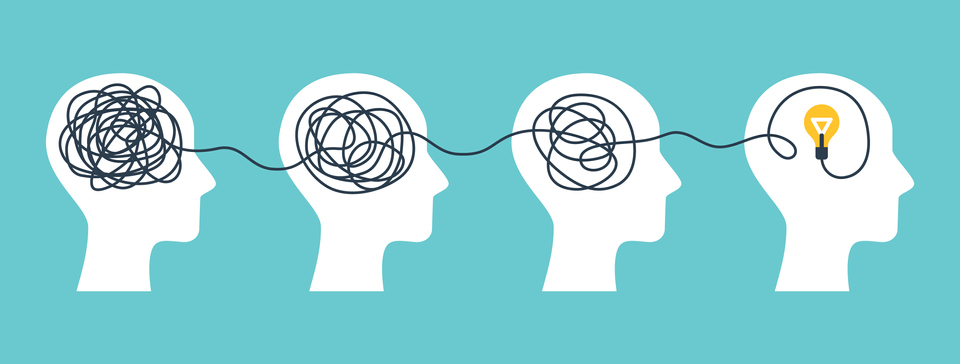DIFFERENT KINDS OF THINKING AND LEARNING: THE COGNITIVE DOMAIN
Since the 1950’s, researchers in cognitive
theory and education have used Bloom’s
(1956) taxonomies of learning. In a number of
landmark papers, Bloom and colleagues
identified three learning domains:
• the cognitive domain
• the affective domain
• the psychomotor domain
The cognitive domain involves thinking of all sorts; it is discussed in some detail below. The
affective domain includes feelings, emotions, attitudes, values, and motivations. Levels within
the affective domain range from initial awareness to a commitment to values that guide behavior
and decisions. The psychomotor domain of learning includes physical movement, coordination,
motor-, and sensory-skills. The psychomotor domain is not considered further in this document.
The other two domains, however, are involved in just about everything that follows. (Read on!).
Although widely used by instructors for course design and student assessment, Bloom’s
taxonomy does not include some of the new kinds of learning deemed important today (e.g.,
learning how to learn, communication and leadership skills, adaptability).
6 Wirth & Perkins - Learning to Learn
Without question, the most widely used of Bloom’s taxonomies is for the cognitive domain.
Bloom divided this domain into six levels of understanding in a hierarchical sequence (Table 1).
According to Bloom, the acquisition of facts (knowledge) marks only the beginning of
understanding. The facts must be understood (comprehension) before they can be applied to new
situations (application).
Knowledge must be organized and patterns recognized (analysis) before
it can be used to create new ideas (synthesis). Finally, to discriminate among competing models
or evidence, the learner needs to be able to assess (evaluation) the relative merits and validity of
information or ideas. Clearly, to attain the level of understanding that makes “evaluation”
possible requires significant time and effort by the learner. Such a sophisticated level of
understanding is not easily attained by simply reading a book or hearing a lecture. It requires
active thought and reflection. Think about something in your own life in which you have
attained a high level of understanding. Perhaps it is a hobby, a sport, or a skill. Try to write
down examples of the different levels of understanding related to this proficiency that you have.
How many hours did you spend dedicated to that task before you attained your current level of
proficiency? Are you prepared to dedicate that much effort to leaning in college?
Bloom and colleagues identified six levels within the cognitive domain. Subsequently,
Anderson et al. (2001) pointed out that there are four categories of knowledge within the
cognitive domain, each requiring different kinds of learning. They identified four principal kinds
of knowledge: factual, conceptual, procedural, and metacognitive. Factual knowledge consists
of isolated and discrete content elements. Conceptual knowledge is more complex and
organized, including such things as knowledge of classifications, categories, principles, theories,
models, and structures. Knowledge of “how to do something” such as techniques, methods and
skills is termed procedural knowledge. Metacognitive knowledge is “knowledge about cognition
and awareness of and knowledge about one’s own cognition.” Anderson et al. (2001) revised
Table 1. Bloom’s levels of thinking, from lowest (1) to highest (6), in the cognitive domain.
This taxonomy, recently revised by Anderson et al. (2001), remains essentially
unchanged, except that synthesis (creating) is considered the highest level of
thinking.
Level of Thinking Example Question That Targets Understanding
1 Knowledge
(facts)
Define the term “mineral”
2 Comprehension
(understand meanings)
Explain why some crystal faces grow faster than others
3 Application
(apply to new situations)
For the 1994 flood in Minnesota, calculate the frequency
of flooding of this magnitude.
4 Analysis
(see organization and patterns)
Compare the distribution of earthquakes along mid-ocean
ridges with those of subduction zones
5 Synthesis
(generalize, create new ideas)
Use the sequence of rocks exposed along the Mississippi
River to construct a model of the changes in sea level
during the early Paleozoic.
6 Evaluation
(assess value of evidence)
Evaluate the arguments for and against the evidence of
fossil life in meteorites from Mars
Wirth & Perkins - Learning to Learn 7
Bloom’s taxonomy and showed that each of their four kinds of knowledge can be mapped across
all six of Bloom’s levels of understanding. So, there are 24 distinct combinations of knowledge
type and level of understanding. In Learning to Think: Disciplinary Perspectives,
Donald points
out that different disciplines involve different and specific kinds of thinking and information.
This, according to Donald explains why students gravitate toward one field or another. It is also
the single most important predictor for success in a given field. Wow, our concepts of learning
and understanding have already gotten a lot more complicated, and we’re not finished yet!

